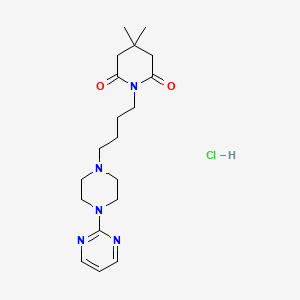



1. 4,4-dimethyl-1-(4-(4-(2-pyrimidinyl)-1-piperazinyl)butyl)-2,6-piperidinedione
2. Bmy 13805
3. Bmy-13805
4. Gepirone
5. Gepirone Monohydrochloride
6. Mj 13805
7. Mj 13805-1
8. Mj-13805
1. Gepirone Hcl
2. Travivo
3. Gepirone Hydrochloride [usan]
4. 83928-66-9
5. Tgfk07ad
6. Bmy 13805-1
7. 80c9l8ep6v
8. Chembl1204187
9. Variza
10. Ariza
11. Bmy-13805-1
12. Gepirone Er
13. 3,3-dimethyl-1-(4-(4-(2-pyrimidinyl)-1-piperazinyl)butyl)glutarimide Monohydrochloride
14. Gepirone Hydrochloride (usan)
15. 2,6-piperidinedione, 4,4-dimethyl-1-(4-(4-(2-pyrimidinyl)-1-piperazinyl)butyl)-, Monohydrochloride
16. Bmy-13805
17. Unii-80c9l8ep6v
18. Bmy 138951
19. Schembl318838
20. Dtxsid30232812
21. Org-33062
22. Gepirone Hydrochloride [mart.]
23. Gepirone Hydrochloride [who-dd]
24. Sb19633
25. Mj-13805
26. D04314
27. Q27269140
28. 2,6-piperidinedione, 4,4-dimethyl-1-[4-[4-(2-pyrimidinyl)-1-piperazinyl]butyl]-, Hydrochloride (1:1)
| Molecular Weight | 395.9 g/mol |
|---|---|
| Molecular Formula | C19H30ClN5O2 |
| Hydrogen Bond Donor Count | 1 |
| Hydrogen Bond Acceptor Count | 6 |
| Rotatable Bond Count | 6 |
| Exact Mass | 395.2088029 g/mol |
| Monoisotopic Mass | 395.2088029 g/mol |
| Topological Polar Surface Area | 69.6 Ų |
| Heavy Atom Count | 27 |
| Formal Charge | 0 |
| Complexity | 476 |
| Isotope Atom Count | 0 |
| Defined Atom Stereocenter Count | 0 |
| Undefined Atom Stereocenter Count | 0 |
| Defined Bond Stereocenter Count | 0 |
| Undefined Bond Stereocenter Count | 0 |
| Covalently Bonded Unit Count | 2 |
Anti-Anxiety Agents
Agents that alleviate ANXIETY, tension, and ANXIETY DISORDERS, promote sedation, and have a calming effect without affecting clarity of consciousness or neurologic conditions. ADRENERGIC BETA-ANTAGONISTS are commonly used in the symptomatic treatment of anxiety but are not included here. (See all compounds classified as Anti-Anxiety Agents.)
Antidepressive Agents
Mood-stimulating drugs used primarily in the treatment of affective disorders and related conditions. Several MONOAMINE OXIDASE INHIBITORS are useful as antidepressants apparently as a long-term consequence of their modulation of catecholamine levels. The tricyclic compounds useful as antidepressive agents (ANTIDEPRESSIVE AGENTS, TRICYCLIC) also appear to act through brain catecholamine systems. A third group (ANTIDEPRESSIVE AGENTS, SECOND-GENERATION) is a diverse group of drugs including some that act specifically on serotonergic systems. (See all compounds classified as Antidepressive Agents.)
Serotonin Receptor Agonists
Endogenous compounds and drugs that bind to and activate SEROTONIN RECEPTORS. Many serotonin receptor agonists are used as ANTIDEPRESSANTS; ANXIOLYTICS; and in the treatment of MIGRAINE DISORDERS. (See all compounds classified as Serotonin Receptor Agonists.)